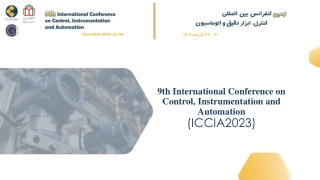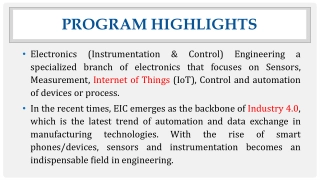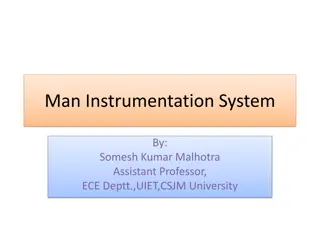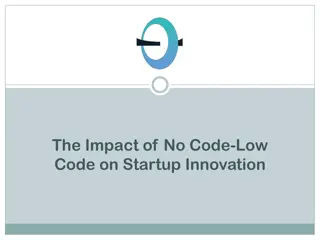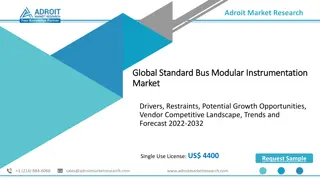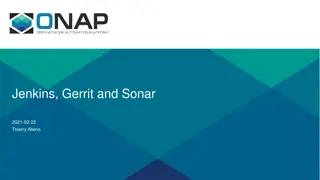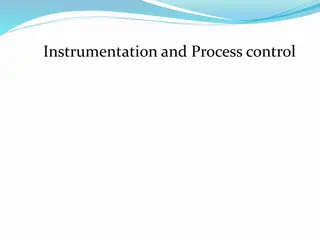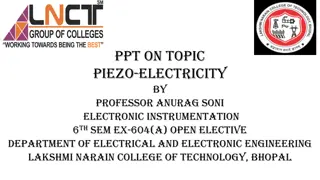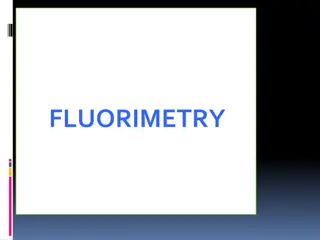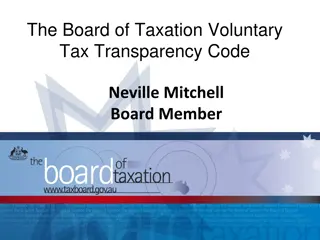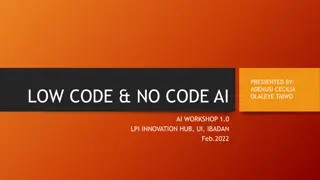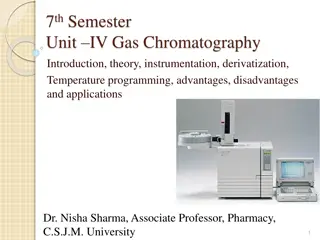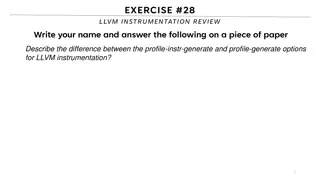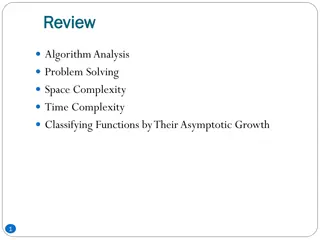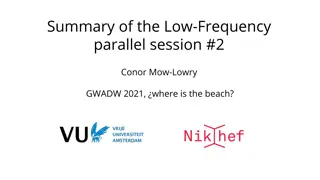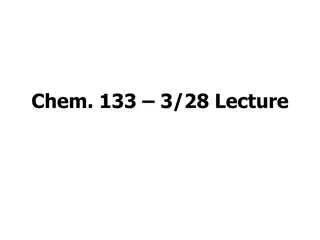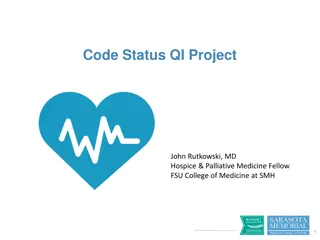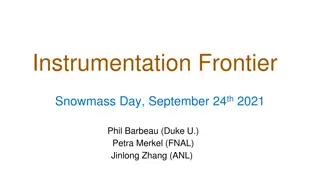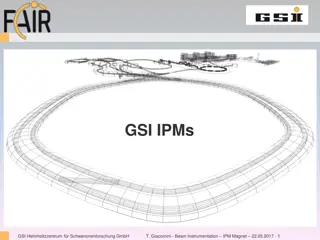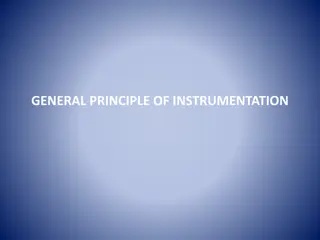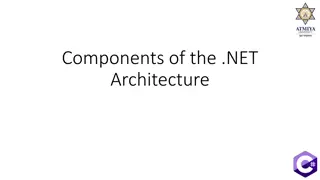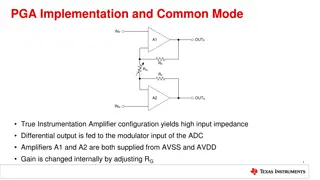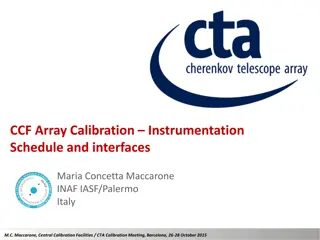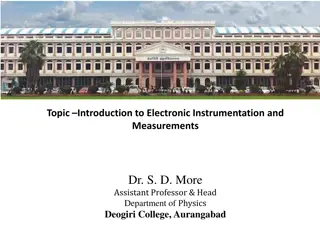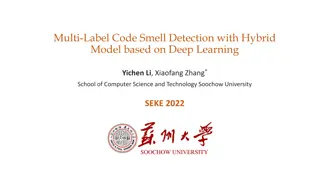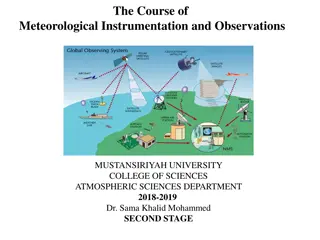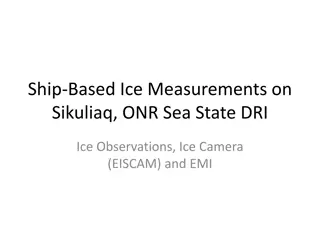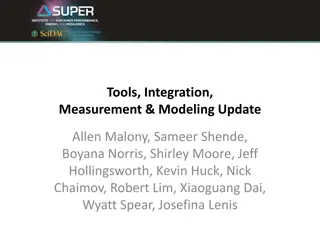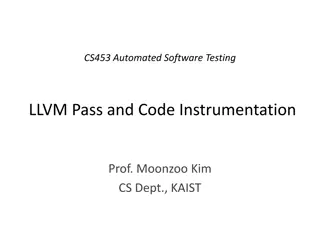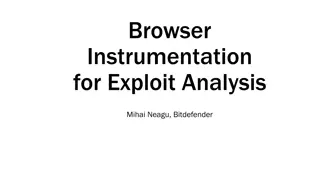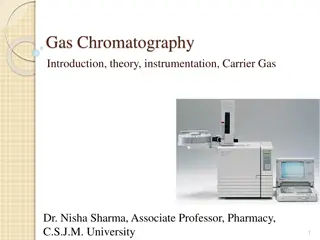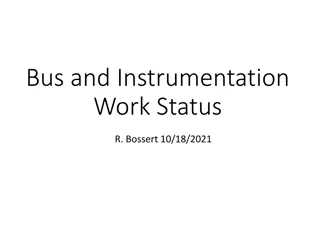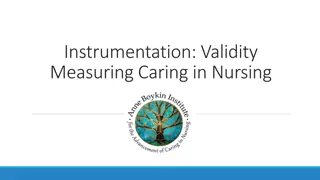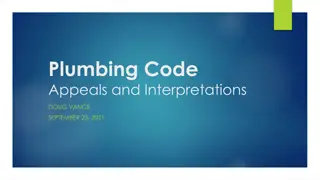9th International Conference on Control, Instrumentation and Automation (ICCIA2023)
Join experts in the field of control, instrumentation, and automation at the 9th International Conference on ICCIA2023. Explore the latest advancements, network with professionals, and gain valuable insights. Don't miss this prestigious event!
3 views • 10 slides
Career Opportunities in Electronics Instrumentation & Control Engineering
Electronics Instrumentation & Control (EIC) Engineering is a specialized branch focusing on sensors, IoT, control, and automation. It plays a crucial role in Industry 4.0 and offers diverse career paths in fields like smart systems, biomedical, and industrial automation. The program at TIET boasts e
0 views • 13 slides
LLVM Instrumentation Overview
Understanding the difference between profile-instr-generate and profile-generate options for LLVM instrumentation is essential for optimizing code performance and analyzing coverage. These options provide different levels of profiling data generation, affecting the accuracy of performance analysis a
0 views • 20 slides
Man Instrumentation System
Biomedical instrumentation involves the use of instruments to measure characteristics or phenomena in living organisms, particularly humans. The interaction between the instrumentation system and the subject being measured is crucial, making the person an integral part of the system. Special conside
0 views • 13 slides
Advanced Instrumentation and Diagnostics for Superconducting Magnets at CERN
Explore the crucial needs for instrumentation and diagnostics at CERN, focusing on superconducting magnets. Topics include voltage and strain measurements, vibration analysis, temperature sensing, quench detection, and magnet form factor considerations. The importance of advanced diagnostics and com
2 views • 23 slides
Comparison Between Static and Dynamic Program Instrumentation
The difference between static and dynamic program instrumentation lies in when the analysis or measurement probes are inserted into a program. Static instrumentation occurs before the program is run and is more closely associated with proactive software evaluation. Dynamic instrumentation, on the ot
5 views • 14 slides
The Impact of No Code-Low Code on Startup Innovation
In the vibrant world of startups, innovation is the cornerstone of success. As these businesses aim to carve out their niches, they often face a common hurdle: the extensive resources required for traditional software development. However, the emergence of low code no code (LCNC) platforms is revolu
2 views • 12 slides
Standard Bus Modular Instrumentation Market
The Standard Bus Modular Instrumentation Market,\u00a0research, a thorough examination of the state of the industry, market size, demand trends, development patterns, and projections from 2022\u00a0to 2032, was just published by Adroit Market Research.
0 views • 5 slides
Improving Code Analysis Workflow with Jenkins, Sonar, and Gerrit
Enhance code analysis processes by analyzing source code before merging, enabling analysis in branches, and triggering Jenkins jobs. Sonar.cloud provides options to analyze branches using Maven build, while the proposal suggests using Jenkins plugin for code review. Addressing challenges with Gerrit
2 views • 12 slides
Understanding Instrumentation and Process Control
This content discusses the importance of measurements in instrumentation and process control, outlining qualities of measurements, the main objectives of process instrumentation, applications of measurement systems, direct and indirect measurements, and functions of instruments such as transmitting,
1 views • 15 slides
Understanding Piezo-Electric Transducers in Electronic Instrumentation
Piezo-electric transducers work on the principle of generating electric charges on a quartz crystal when a force is applied, producing piezoelectricity. This technology is ideal for dynamic measurements due to its high response rate. The transducer's output voltage is proportional to the applied for
0 views • 13 slides
Understanding Fluorimetry: Principles, Applications, and Instrumentation
Fluorimetry is a technique that measures fluorescence intensity of molecules when excited by radiation. It involves the promotion of electrons from ground to excited states, leading to emission of radiation. This process includes singlet and triplet states, as well as relaxation mechanisms like Coll
0 views • 45 slides
Understanding Binary Coded Decimal (BCD) and Excess-3 Code
Binary Coded Decimal (BCD) is a binary code used to represent decimal numbers, with the popular 8421 BCD code and its conversion process explained. Additionally, Excess-3 Code, another BCD code, is detailed with an example of finding its code for a given decimal number. Different BCD codes like 4221
0 views • 11 slides
A New Complaint Handling Code for the Sector - Webinar Highlights
This webinar discusses the introduction of a new Complaint Handling Code for the sector, aiming to address issues in social housing complaint processes. It covers key points, the background leading to the code's development, the Ombudsman's experience, and the code's aims and framework towards high-
0 views • 14 slides
The Board of Taxation Voluntary Tax Transparency Code Overview
The Board of Taxation developed a voluntary Tax Transparency Code to address community concerns and promote greater tax transparency among large businesses. The Code outlines recommended disclosures for both large and medium businesses, encouraging adoption of higher disclosure standards. Internatio
0 views • 20 slides
Simplifying AI Development with Low-Code and No-Code Platforms
Explore the world of low-code and no-code AI development platforms, empowering experts to create applications with ease. Learn about the benefits, tools, and components of these innovative platforms, and discover popular AI tools for no-code development. Accelerate your digital transformation journe
0 views • 11 slides
Gas Chromatography: Introduction, Theory, Instrumentation, Derivatization
Gas chromatography is a powerful analytical technique used for separating and analyzing volatile compounds. It involves a mobile gas phase passing through a stationary phase, with components in the mixture interacting differently, resulting in separation. The technique dates back to 1905 and has evo
0 views • 12 slides
Understanding the Difference Between LLVM Profile-Instr-Generate and Profile-Generate Options
The profile-instr-generate and profile-generate options in LLVM instrumentation serve distinct purposes. Profile-instr-generate generates instrumentation based on profiling data during compilation, aiding in performance optimization. In contrast, profile-generate is used to generate a profile based
1 views • 20 slides
Understanding Pseudo Code and Flow Charts for Algorithm Analysis
Explore the concepts of pseudo code and flow charts for analyzing algorithms, problem-solving, and understanding space and time complexity. Learn about basic elements of pseudo code, assigning operations, and writing effective pseudo code statements in a clear and structured manner. Discover the imp
0 views • 26 slides
Advanced Understanding of Low-Frequency Noise in Instrumentation
Understanding low-frequency noise in instrumentation has advanced significantly, emphasizing the need for an integrated approach to predict and mitigate such noise. Recent studies show that low-frequency noise in third-generation instruments is exceptionally better than in second-generation detector
0 views • 11 slides
Introduction to Spectroscopic Instrumentation and Monochromators
Today's lecture covers spectroscopic instrumentation with a focus on monochromators. It delves into the components and performance measures of spectrometers, including wavelength discrimination filters, light detectors, and energy dispersive detectors. The dispersion of light through prisms and grat
0 views • 17 slides
Understanding Industrial Instrumentation Transmitters: A Comprehensive Guide
Industrial instrumentation transmitters play a crucial role in converting readings from sensors into standard signals for monitoring and control. Learn about different types of signals, such as pneumatic, analog, and digital, and how transmitters function in various industrial processes. Dive into e
0 views • 20 slides
Enhancing Code Status Discussions in End-of-Life Care: A Quality Improvement Project
This project led by Dr. John Rutkowski aims to reduce inappropriate interventions for patients with DNR or Modified Code Status by implementing an improved code status documentation system. Data analysis reveals a need for better documentation practices, and survey responses highlight various challe
0 views • 18 slides
Latest Updates on Instrumentation Frontier Activities - September 2021
Instrumentation Frontier activities are picking up pace after the pause in early 2021. Various groups are resuming meetings and workshops, with plans for White Paper kick-off and wrap-up workshops in the coming months. Each subgroup is organizing and categorizing LOIs to drive progress in Quantum Se
0 views • 13 slides
Overview of Beam Instrumentation at GSI
Beam instrumentation at GSI, specifically focusing on IPMs, plays a crucial role in managing various aspects of accelerator operations. The images and descriptions provided highlight the use of IPMs for setting up different ion sorts, beam width monitoring, cooling and injection optimization, and fa
0 views • 28 slides
Principles of Dental Instrumentation and Patient Positioning
Understanding the general principles of dental instrumentation is crucial for efficient dental procedures. This includes aspects such as instrument activation, maintaining a clean field, and proper positioning of the operator and patient for optimal visibility and accessibility. Attention to detail
0 views • 23 slides
Understanding the .NET Architecture Components
The .NET architecture comprises various key components such as the Common Language Specification, Code Manager, Managed Code, Unmanaged Code, and Native Code. These components play crucial roles in the development and execution of applications within the .NET framework. Managed code is executed by t
0 views • 21 slides
Understanding PGA Implementation and Common Mode Voltage in Instrumentation Amplifiers
The PGA implementation in instrumentation amplifiers allows for high input impedance and precise gain adjustment through internal settings. Common mode voltage plays a crucial role in ensuring proper amplifier operation, with limitations and potential violations impacting signal integrity. Examples
1 views • 5 slides
Array Calibration Instrumentation Interfaces and Schedule by Maria Concetta Maccarone at CTA Calibration Meeting
Maria Concetta Maccarone from INAF IASF/Palermo presented on the instrumentation interfaces and schedule for array calibration within the CCF project at the CTA Calibration Meeting in Barcelona. The presentation discussed major interfaces within the CTA instrument, methods for calibration, and the i
1 views • 6 slides
Understanding Significant Figures in Electronic Instrumentation
Everyday measurements often require significant figures to account for precision and accuracy. Learn about the importance of significant figures in electronic instrumentation, how to interpret them, and why they are crucial for precise measurements in scientific fields such as physics.
0 views • 20 slides
Multi-Label Code Smell Detection with Hybrid Model based on Deep Learning
Code smells indicate code quality problems and the need for refactoring. This paper introduces a hybrid model for multi-label code smell detection using deep learning, achieving better results on Java projects from Github. The model extracts multi-level code representation and applies deep learning
0 views • 10 slides
Meteorological Instrumentation and Observations Overview
Overview of weather maps, symbols, and the weather station model used in meteorological instrumentation and observations. Explains the importance of weather charts in forecasting processes. Also introduces the FM System of Code Forms for reporting weather observations. Helpful resources for students
0 views • 42 slides
Comprehensive Ship-Based Ice Measurements and Observations on Sikuliaq for Sea State DRI
This collection of images showcases various ship-based ice measurements and observations conducted on the research vessel Sikuliaq for Sea State DRI. The images include aspects such as sea ice observations, snow and ice thickness measurements, evaluation of orthorectification, and new snow and ice i
0 views • 8 slides
Update on Tools Integration, Measurement, and Modeling
TAU, a performance analysis framework, is being ported to ARM64 Linux and Power 8 Linux environments with updated instrumentation features. It offers measurement sampling support and integrates with various libraries for efficient performance tracking. Additionally, the TAU interface enables energy
0 views • 22 slides
Automated Software Testing with LLVM Pass and Code Instrumentation
This content delves into LLVM Passes, the LLVM Pass Framework, control flow graphs in LLVM IR, and an example Pass implementation called IntWrite for monitoring integer variable updates. It explains the process, concepts, and tools involved in automated software testing using LLVM Passes and code in
0 views • 18 slides
Insight into Browser Instrumentation for Exploit Analysis
Explore the complex world of browser instrumentation and exploit analysis through the lens of Mihai Neagu's research at Bitdefender. Delve into the intricacies of exploit kits, malware delivery services, behavior analysis, and hidden aspects of exploit execution processes.
0 views • 19 slides
Gas Chromatography: Introduction, Theory, and Instrumentation
Gas chromatography is a powerful analytical technique used to separate and analyze volatile substances. Originating in 1905, it involves the partition between a gas and a solid or liquid stationary phase. The theory revolves around retention time and the tentative identification of unknown compounds
0 views • 10 slides
Bus and Instrumentation Work Status Update - October 18, 2021
Status update on bus and instrumentation work including completion of bus work on Qa and Qb sides, implementation of wiring for pre-series cold mass, progress on spool assembly, and modifications to bus fabrication. Various checks and verifications have been completed as part of the ongoing work.
0 views • 6 slides
Understanding Validity in Nursing Instrumentation
Validity in nursing instrumentation is crucial for measuring caring effectively. It involves ensuring that the instrument reflects the abstract construct being examined and measures what it is supposed to measure. Face validity, content validity, and theoretical validity play essential roles in esta
0 views • 27 slides
Plumbing Code Appeals and Interpretations Overview
This document provides information on the agenda, upcoming professional development events, Building Code Appeal Board, Appeal Board decisions, Code Interpretation Committee, code interpretations, and final thoughts related to plumbing code appeals and interpretations. It covers the appeal process,
0 views • 8 slides
